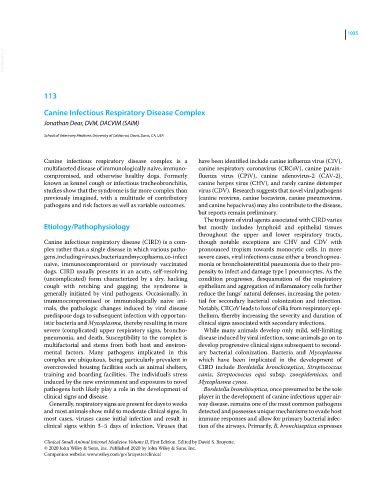Page 1097 - Clinical Small Animal Internal Medicine
P. 1097
1035
VetBooks.ir
113
Canine Infectious Respiratory Disease Complex
Jonathan Dear, DVM, DACVIM (SAIM)
School of Veterinary Medicine, University of California, Davis, Davis, CA, USA
Canine infectious respiratory disease complex is a have been identified include canine influenza virus (CIV),
multifaceted disease of immunologically naive, immuno- canine respiratory coronavirus (CRCoV), canine parain-
compromised, and otherwise healthy dogs. Formerly fluenza virus (CPiV), canine adenovirus‐2 (CAV‐2),
known as kennel cough or infectious tracheobronchitis, canine herpes virus (CHV), and rarely canine distemper
studies show that the syndrome is far more complex than virus (CDV). Research suggests that novel viral pathogens
previously imagined, with a multitude of contributory (canine reovirus, canine bocavirus, canine pneumovirus,
pathogens and risk factors as well as variable outcomes. and canine hepacivrus) may also contribute to the disease,
but reports remain preliminary.
The tropism of viral agents associated with CIRD varies
Etiology/Pathophysiology but mostly includes lymphoid and epithelial tissues
throughout the upper and lower respiratory tracts,
Canine infectious respiratory disease (CIRD) is a com- though notable exceptions are CHV and CDV with
plex rather than a single disease in which various patho- pronounced tropism towards monocytic cells. In more
gens, including viruses, bacteria and mycoplasma, co‐infect severe cases, viral infections cause either a bronchopneu-
naive, immunocompromised or previously vaccinated monia or bronchointerstitial pneumonia due to their pro-
dogs. CIRD usually presents in an acute, self‐resolving pensity to infect and damage type I pneumocytes. As the
(uncomplicated) form characterized by a dry, hacking condition progresses, desquamation of the respiratory
cough with retching and gagging; the syndrome is epithelium and aggregation of inflammatory cells further
generally initiated by viral pathogens. Occasionally, in reduce the lungs’ natural defenses, increasing the poten-
immunocompromised or immunologically naive ani- tial for secondary bacterial colonization and infection.
mals, the pathologic changes induced by viral disease Notably, CRCoV leads to loss of cilia from respiratory epi-
predispose dogs to subsequent infection with opportun- thelium, thereby increasing the severity and duration of
istic bacteria and Mycoplasma, thereby resulting in more clinical signs associated with secondary infections.
severe (complicated) upper respiratory signs, broncho- While many animals develop only mild, self‐limiting
pneumonia, and death. Susceptibility to the complex is disease induced by viral infection, some animals go on to
multifactorial and stems from both host and environ- develop progressive clinical signs subsequent to second-
mental factors. Many pathogens implicated in this ary bacterial colonization. Bacteria and Mycoplasma
complex are ubiquitous, being particularly prevalent in which have been implicated in the development of
overcrowded housing facilities such as animal shelters, CIRD include Bordetella bronchiseptica, Streptococcus
training and boarding facilities. The individual’s stress canis, Streptococcus equi subsp. zooepidemicus, and
induced by the new environment and exposures to novel Mycoplasma cynos.
pathogens both likely play a role in the development of Bordetella bronchiseptica, once presumed to be the sole
clinical signs and disease. player in the development of canine infectious upper air-
Generally, respiratory signs are present for days to weeks way disease, remains one of the most common pathogens
and most animals show mild to moderate clinical signs. In detected and possesses unique mechanisms to evade host
most cases, viruses cause initial infection and result in immune responses and allow for primary bacterial infec-
clinical signs within 3–5 days of infection. Viruses that tion of the airways. Primarily, B. bronchiseptica expresses
Clinical Small Animal Internal Medicine Volume II, First Edition. Edited by David S. Bruyette.
© 2020 John Wiley & Sons, Inc. Published 2020 by John Wiley & Sons, Inc.
Companion website: www.wiley.com/go/bruyette/clinical

